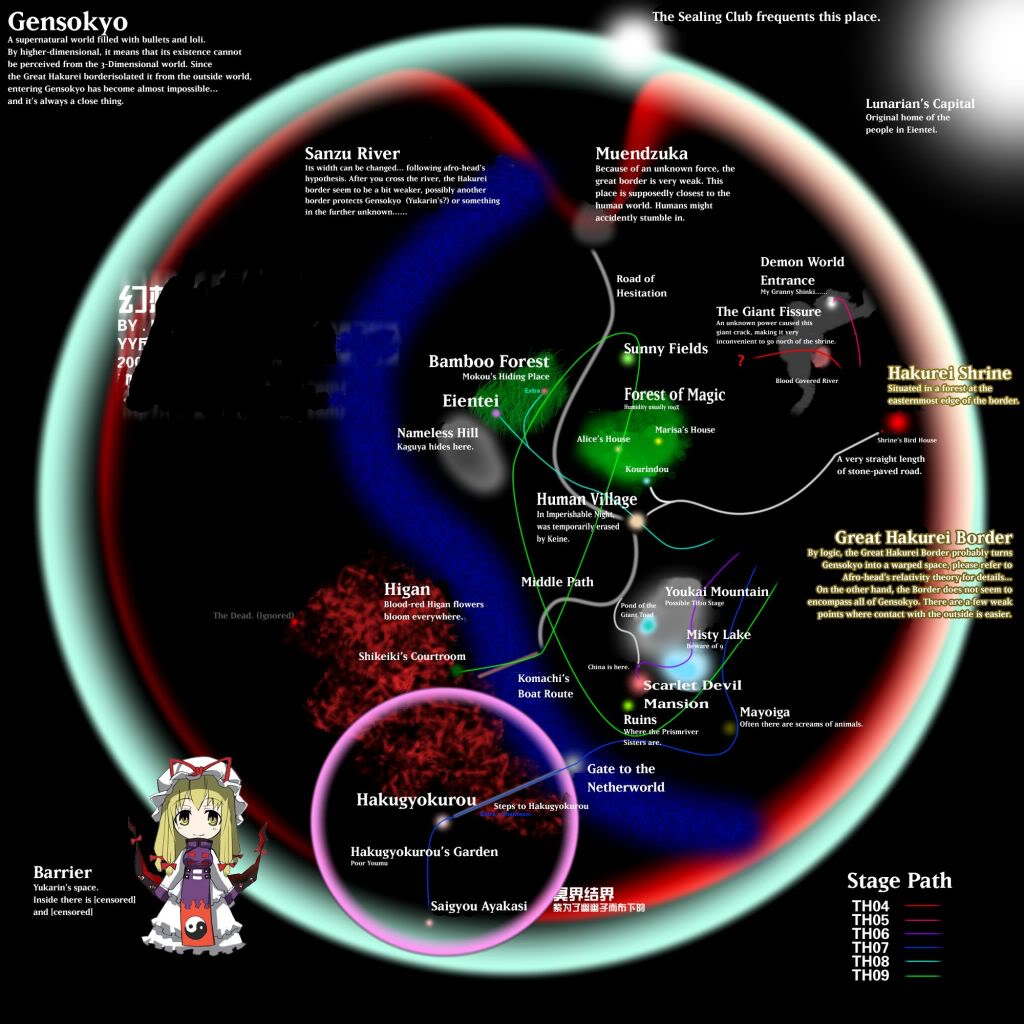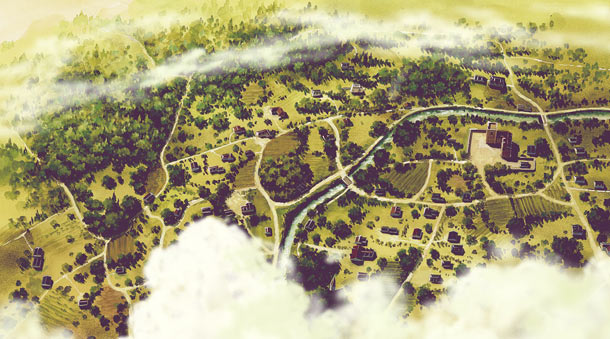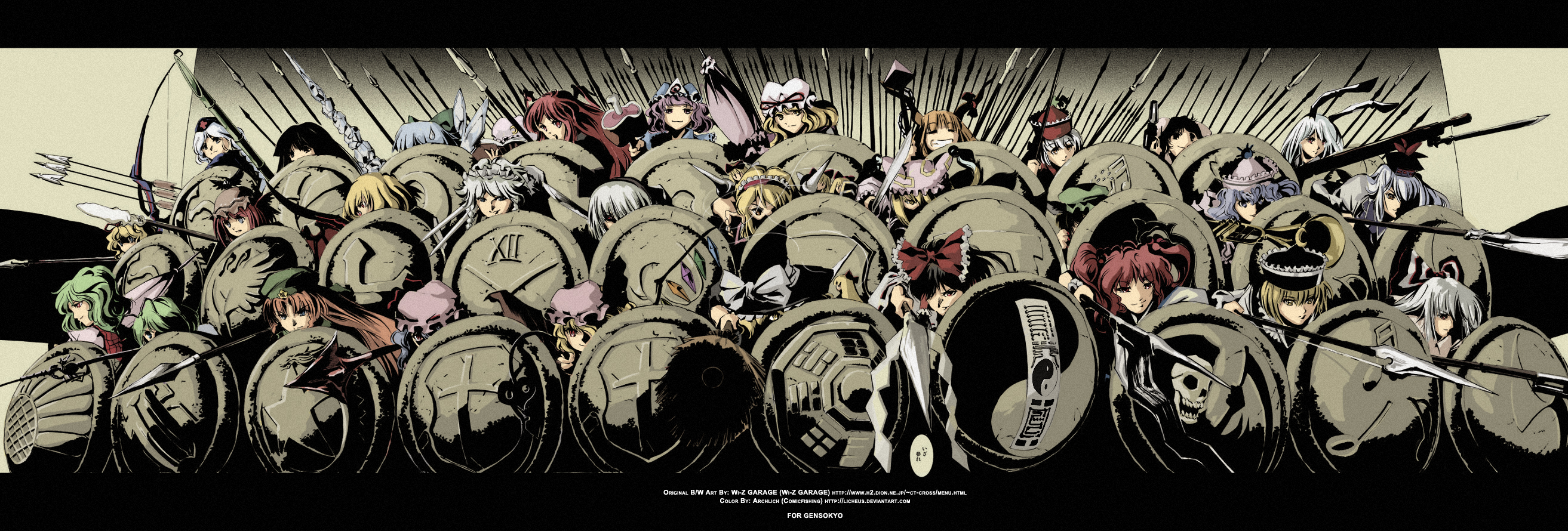Seeing the World of Gensokyo
BY DIGIBRO

One of the things that anime is surprisingly not very good at is creating a fully-realized fictional ‘world.’ When you open up a fantasy book (and fantasy is of course the best genre for fictional worlds) you are often confronted with a ‘world map’ right off the bat. You will be given details about all sorts of countries and locations and customs, etc., to bring this world to life as you read. The reason that this doesn’t really happen in anime is for the same reason it does happen a whole lot in JRPGs – time.
Anime aren’t long – usually, they are 4-8 hours long, which is hardly enough time to create a whole world and fill it with meaningful characters (Lord of the Rings trilogy took about 10 hours – around 30 episodes of anime? And good luck finding many any as good as LOTR). Actually, the biggest beef I have with a lot of anime stylistically, especially in fantasy and adventure series, is the lack of a fully realized world. It’s the meat that makes you feel like what you are watching is really happening somewhere, and not just anonymously existing in a world bent to the convenience of the story.
I like Scrapped Princess, but it had this terrible lack of sense about the world. We knew that the characters were fleeing one country for the next, but we never knew how big these countries were, or how far along they had traveled, or what this country was like. That show comes forth with a lot of details that are so out of left-field that they have you constantly reconciling new developments against what you’ve seen so far, and then you have to realize ‘the world was always intended to be that way, they just didn’t tell me so.’ (I guess that’s what the novels the show is based on are for.) Even a series with a beautiful, stylized world like Last Exile fails to give you any real sense of the world, and that show too gets a little head-scratchy when the world suddenly looks different in ways you didn’t expect late in the game. All of this is why most anime stay away from world-building altogether and reuse the same familiar landscapes, or otherwise make the world ‘consistently random.’
A series like One Piece or Kino’s Journey can use a set-up to their advantage where they keep certain things consistent throughout the series so that the world all feels ‘together’, but use the fact that all of the locations are far apart from one-another to make each one unique on the author’s whim.
If there is one series that stakes the claim of moving in the right direction, it’s 12 Kingdoms (I guess deserving of it’s title as one of the greatest anime fantasy series of all time) which gives you a world map and does a lot to develop that world and… until it ends after 45 episodes, leaving a lot of it yet to be explored, and therefor alien to the viewer. As it stands, I think that the only anime that have even been long enough to do a good job developing their worlds have been shounen action shows like Dragon Ball and One Piece, but once again, they are so random in their consistency that it’s hard to think of the world as cohesive.

And I’m not saying here that anime cannot create good ‘settings’. Haibane Renmei, the Aria series, and now Sora no Woto have shown us that anime can create an amazing setting, but you’ll notice that all of those series take place almost entirely in one city. That, I’m afraid, I cannot consider a ‘world’ (even a continent might be fine for that consideration, but not a city.) I want to see a ‘world’ like a JRPG has – I can fully visualize the world map of Tales of Symphonia 5 years after playing it because it was such a fully realized, fully explorable, and immersive world. But then wait – why the hell can I see Gensokyo more clearly than any other world?!
I’m not basing that on non-canonical Gensokyo, either. If you’ve ever played any Touhou, a ‘bullet hell’ shooter game series, then you know that the background art is quite generic, and you can only even get a semblance of where you are at any time by the game’s vague dialog. However, there is something magical about what ZUN has created in the Touhou franchise, and I feel this applies to the characters as well as the world they live in – it’s built entirely on implications.
Having a look at, for example, the story of Embodiement of Scarlet Devil. From the past games in the series, we have established that the lead character, Reimu, lives in a shrine in the world of Gensokyo, which is largely populated by all sorts of classical Japanese monsters, some humans, and a lot of eccentric people. In EoSD, we learn that there is a mansion somewhere that Remilia Scarlet and her family lives in, and it’s where the main character goes to beat the game. The first stage has the character flying through a long forest, the second over a massive lake, and the third at the strange-looking entrance to the mansion. Therefor, we can create an image in our head that if you leave the forest surrounding Reimu’s house, fly for quite a while, and pass over a huge lake, you will eventually get to the Scarlet Devil Mansion. We learn that the mansion has a massive library, as well as that it is bigger on the inside than it is on the outside, and that it is populated by many, many maids.
We are given only a couple of lines of dialog from each character we meet with only the tiniest implications of their personalities. ZUN has written some background information on them, but it is mostly ‘telling.’ He tells us a lot of things about the characters, but even when he does, he is sketchy about it, claiming a lot of things to be ‘rumors’ or stating that sources may be more or less correct than they seem. The only time he gives us any scenarios involving the characters, it has a strong bias on the part of the narrators in question, skewing information further.
Point being, there isn’t a whole lot that is given to the player as ‘facts about Touhou’, but a lot of things that are given as ‘inspiration.’ With Touhou, it is possible to completely create the world and the characters inside of your head, all your own, and yet be correct about it.

If you read me a lot, you probably have seen me talk a lot about ‘creators intent’. If there is one thing I think of myself as great at, it is metering creator intent. I look at the background info of a show, the previous works of a creator, what I can find about their personality, what the scenes and the dialog mean at their core, and I gauge what it is I think the creators of a series really intended for you to see with their part in it. Because of this, I don’t really use my imagination too much about what isn’t given to us in a series. I don’t go adding things into a fictional world that I may not know have a place there, because I am more interested in what the creators wanted me to see (and likewise, when I create things, I don’t like to leave much open for debate – I want you to fully understand my message, which is probably why I qualify my statements so much, lol.) Now, if I truly feel that I grasp the intent of the creators, I can expand on it. I would feel comfortable writing a fan-fiction about the future romance of Ryuuji and Taiga from Toradora, because I feel that I grasp their characters and their story perfectly, and that I could represent them in-line with the narrative. However, sometimes, there are series that give you more breathing room.
I’m talking about when the creator’s intent is for the viewer to find their own meaning. I find myself taken to the band System of a Down, who in interviews would always state that they would never ‘explain’ the meanings of their lyrics, because they wanted the fans to come up with their own. As a lifelong listener of their music, I have of course developed meanings for all of their songs, and I can completely be confident that all of my meanings are ‘correct’ because the band stated themselves that their intent was for me to assume that of my own interpretation.
Touhou is likewise a series wherein I feel a lot has been purposefully left to the consumer. ZUN will tell you some things and dispel some rumors so that the characters and the world have some ‘official’ aspects, but the whole of the worldview is also ‘officially’ as you interpret it. Therefor, even though there is no provided view of the world of Gensokyo, I can be utterly confident in my vision of it, as comprised from the random facts and ‘inspirations’ laid before me. In my head, there is a calculated distance between the human village, the Eientei mountain, and the Scarlet Devil Mansion, and I can mentally travel the characters from one location to the next and let them interact with one another in the perfect light that I imagine them to interact.
This is why Touhou is such an engrossing franchise for me. It has endless possibilities, because it is not weighed down by what content exists. I love Neon Genesis Evangelion, because it provides me with a lot to think about, but the bottom line is that it will never be more than it is to me. As much digging as I could do to find all of it’s treasures, I will eventually ‘know everything about Eva’, and while I will love that, it will simply be all there is. I will never run out of scenarios for Gensokyo. In my mind, I can make anything happen there, and therefor I can never stop finding new things to love about the series. I think it’s pretty amazing that I feel so attached to the characters and their world just from reading straightforward facts and concepts surrounding them, but I have already imagined so much of their existence that it’s like I’ve watched them for hundreds of episodes. I can safely say that I know more and have a better vision of Gensokyo than I ever have had of an anime world.